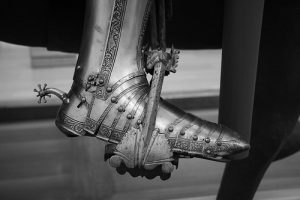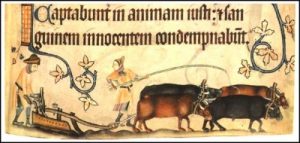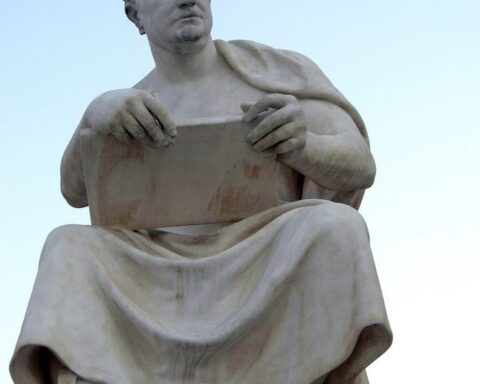What Is This Book About?
Lynn White, Jr. presents the concept that changes in technology caused social change in medieval Europe (Roland, 574). This social change resulted in the rise of feudalism, based upon the change in methods of warfare, agriculture, and in harnessing mechanical power. Rather than viewing feudalism’s formation from a legal or constitutional viewpoint, White claimed that it was military in nature, with the role of the cavalry at its heart (White, 2-3). This was the result of the introduction of the stirrup, and consequent changes in weaponry.
Warfare was not the only thing that changed; the role of the plough for agricultural productivity, with the technological developments, allowed one farmer to cultivate more land that had previously been possible, especially after horsepower was introduced. Since the vast majority of the population was engaged in agricultural pursuits, this freed some individuals to pursue other ventures, or to serve in other roles in society, leading to urbanization (White, 39, 47ff).
The harnessing of mechanical power allowed for a more effective work force, allowing for better milling, water movement, air blowing, etc. Less man-power was necessary to accomplish tasks, increasing productivity. It also prompted scientific inquiry, which White insinuates helped propel the search for methods of human flight and undersea travel. In effect, medieval technological advanced set the stage for social organization, modern scientific discoveries, and industrialization.
 Why Did The Author Write The Book?
Why Did The Author Write The Book?
White believed that technology’s role in the development of human affairs has been neglected. Historically, the groups of people who have been focused on technology are not those normally concerned with writing, so that it is often difficult to determine the impact that individual technological advancements have had from reading historical accounts. The author intended to provide a resource for “the general student” that might be interested in “the relation between technology and the alteration of social forms” (White, vi).
White perceived the Middle Ages to be coherent and rational. While many historians believed the era to be technically stagnant, White believed it to be very dynamic, with a major influence on the ages that followed (Roland, 574). Rather than being isolated, the culture of Medieval Europe was related to the other cultures of the eastern hemisphere (White, v). He desired to demonstrate that small technological advancements could spread, causing major cultural changes. As Roland states, “he brought insight and imagination to a wide range of evidence” (574), showing that the history of technology was important.
What Is The Main Thesis/Argument Of The Book?
White claimed to have three purposes in writing the book. First, it presents three studies focused upon the role that technology played in social changes in the European Middle Ages. Second, it introduces sources and methods of study that are important to learn about unwritten history, such as the development of technology. Third, it shows that the eastern hemisphere was more inter-related than previously believed (White, v). Primarily, scholars have focused upon the first purpose, as it takes up the bulk of the book. The second purpose is primarily presented in the notes, while the third is spread throughout the book.
The book has three major sections, one for each of the three aforementioned studies. The first, and most controversial, claimed that the introduction of the stirrup allowed a rider to remain stable in combat, eventually leading to the development of feudalism (Roland, 575). The second section focused upon the role that developments in plough technology, horseshoes, horse collar, and more had upon agriculture in the Middle Ages (Roland, 576). The final section discussed mechanical power and the way in which it was harnessed, such as with cranks (Roland, 576).
The sources and methods for continuing study of the subject covers over 40 pages of notes in the back of the book, in addition to the footnotes spread throughout the first 134 pages of text. White did not necessarily fully develop each topic that was presented, but did provide voluminous notes that allow the reader to do further research. Most of the resources support White’s theses, but he does provide some that are critical. He based his research upon the work of prior historians, and the notes begin with them: Heinrich Brunner (stirrup), Marc Bloch (plough), and Lewis Mumford and others (mechanical power).
The third intention of the book, to demonstrate the inter-relation of the eastern hemisphere, is deduced from the sources that White used, as well as the examples he provides throughout the book. “To understand the sources and ramifications of developments in medieval Europe one must search Benin, Ethiopia and Timor, Japan and the Altai” (White, v).
What Are The Main Ways In Which The Author Supports The Thesis/Argument?
White organized his book into four sections: one for each of his theses and another for the notes, as previously mentioned to argue his point, both directly and indirectly. In each of the sections examples, notes, and data are provided which develop his theses, as well as establishing the connection between Europe and other parts of the world, and providing a starting point for continued studies.
Building upon the work of Heinrich Brunner, White posits that while Brunner missed the mark on a few details, his basic framework was sound – the early Carolingians created feudalism, as land was confiscated from the Church and given to supporters of the King. White concluded that it was the introduction of the stirrup that led to this social change, rather than Charles Martel’s experiences at the Battle of Poitiers, as Brunner has argued. The stirrup allowed the rider to maintain his seat, even in combat. This also led to a major change in weaponry; since the rider was stable, he was able to engage in “shock combat” (White, 28).
White showed that the stirrup arrived in Europe in the early eighth century. It was originally developed in Asia, and followed the trade routes. He traced the development via artwork and historical documents, showing how stirrups developed and then spread across Europe. At the same time, social changes were taking place, as the Knight came into military prominence. White does not say that it was necessary that Feudalism resulted, but that the stirrup made it possible. European society had “social, political, military, and economic forces” that were at play, and the stirrup was a part of that mix that eventually resulted in Feudalism (Roland, 583).
Building upon the work of Marc Bloch, White’s second section discussed how the development of the heavy plow, plowshare, and other agricultural advancements allowed Europeans to increase productivity, especially in regions that had been previously untillable. Surpluses in food, and other social changes caused an increase in urbanization, technical specialization, and in leisure time (Roland, 576). Since much of the previously untillable soil had been in northern Europe, the power center shifted to the north, as more people, produce, and capital were produced in that region, relative to the south. White discusses potential sites for the origin of the heavy plough, such as Slavic lands, though he admits it could have been developed elsewhere (White, 49).
 White introduced the concept that horses came to replace oxen, leading to continued increases in productivity. The harness, and nailed horseshoe were instrumental in this development (White, 57). Though oxen and horse are compatible in strength, the horse is faster, resulting in a major increase in foot-pounds per second (White, 62), showing that it would take two oxen to match one horse. Since this allowed one person to cultivate more land that had been previously possible, providing for a suitable environment in which feudalism could develop. The standard of living increased, allowing the worker to purchase manufactured goods, which, along with industrial specialization, led to increased urbanization.
White introduced the concept that horses came to replace oxen, leading to continued increases in productivity. The harness, and nailed horseshoe were instrumental in this development (White, 57). Though oxen and horse are compatible in strength, the horse is faster, resulting in a major increase in foot-pounds per second (White, 62), showing that it would take two oxen to match one horse. Since this allowed one person to cultivate more land that had been previously possible, providing for a suitable environment in which feudalism could develop. The standard of living increased, allowing the worker to purchase manufactured goods, which, along with industrial specialization, led to increased urbanization.
White’s third section examined how medieval Europeans came to harness and transmit mechanical power. Water, wind, falling weight, and chemical power were discussed (Roland, 576). The crank received special attention, as White claimed it was the most important invention since the wheel (White, 103). Where the crank was invented was not really determined, though claims were made for ancient Egypt, China, and elsewhere. Various potential examples of cranks from antiquity were also considered (White, 104-107).
In any event, once the crank was introduced to Europe, it was quickly adapted to various purposes, such as the flywheel, windmill, leading to continuous rotary motion (White, 115-117). This allowed lathes, treadles, and other such machines to increase productivity even more. The clock was another important result, which White devotes several pages to discussing.
The connection between Asia and Europe is again discussed, showing that many of the instruments necessary for harnessing and distributing power were originally invented in Asia (India or China), but not fully developed and implemented until reaching Europe. Once water and wind were harnessed, things such as magnetism were attempted, resulting in the compass, which eventually led to European circumnavigation. Further, White highlights the point that the imagination that Europeans began to develop inspired mankind to ponder flight and deep-sea navigation (White, 132-134).
Forty-three pages of notes follow the end of the text in White’s book. These notes are in addition to the multiple notes found at the bottom of each page of text. They provide references to sources used by White in developing his theses, as well as for further study. Not only do they provide a starting place for more research, but they explain in more detail some of the points that White attempted to make in the book.
In addition to the notes, there are plates, or pictures, provided that support White’s theses. These pictures show everything from the development (and placement) of stirrups, harnesses, cranks, and more. They allow the reader to make a connection between White’s words and the sources that he used to determine his conclusions.
Each part of the book focuses upon one particular thesis, not really engaging the others. The exception is that that each section illustrates how Europe was actually connected to other parts of the world. This allowed technological advances from various places to reach Europe and be adapted to the particular climate and implemented in a way that supported the social change that was taking place.
What Are The Strengths And Weaknesses Of The Book?
White’s book dealt with important topics of continuing historical significance. Not only did White use respected sources, but his analysis included ten languages, multiple “categories of evidence, from epigraphy and archaeology to anthropology and philology” (Roland, 574). He demonstrated that technology was an important discussion point, specifically in the Middle Ages, when it had previously been assumed that technology was not a viable topic for that period. He made the point that social change was affected – and even caused – by changing technology. His focus on technology centered on seldom studied artifacts, such as stirrups, shoes, cranks, etc. (Roland, 574). While it may be vilified by many historians, it has been in print for nearly 50 years, demonstrating its staying power. Not all of his arguments have proven correct, but even those that have failed have led to useful research. White was a good writer, and he used wit, clearly worded prose, and effective rhetoric. Simply put, there is no better book on the topic, and his basic outline and argumentation is still valid (Roland, 583-84).
In spite of the book’s strengths, there are numerous concerns. The large number of notes and references could be considered “padding,” according to Roland (582). White tended to favor evidence that supported his views, and often overlooked that which was contrary. In addition, scholars have successfully challenged his theses on various points. White’s arguments about stirrups affecting the organization of Charles Martel’s army being one example. The criticism claimed that White’s arguments (and even criticism of it) were “interesting but esoteric and inconclusive,” and in need of more debate (Roland, 577). As Roland states, it is even possible that some of his arguments could be reversed, such as increasing population sparked an agricultural revolution, contrary to White’s thesis (584). Finally, though White was a talented writer, he has been accused of misleading his readers intentionally, deliberately provoking the historical community.
References
White, Lynn Jr. 1964. Medieval Technology & Social Change. London: Oxford University Press.
Roland, Alex. 2003. “One More Into the Stirrups: Lynn White Jr., ‘Medieval Technology and Social Change.’” Technology and Culture. Vol 44, No. 3. Pp. 574-585.







I never fully understood why the Medieval period is treated as if the sobriquet “Dark Ages” was a realistic description of the times.
It sounds like the weaknesses of White’s work are overshadowed by the strengths.
It was a useful book. It gave some valuable insights into how technology affected culture.